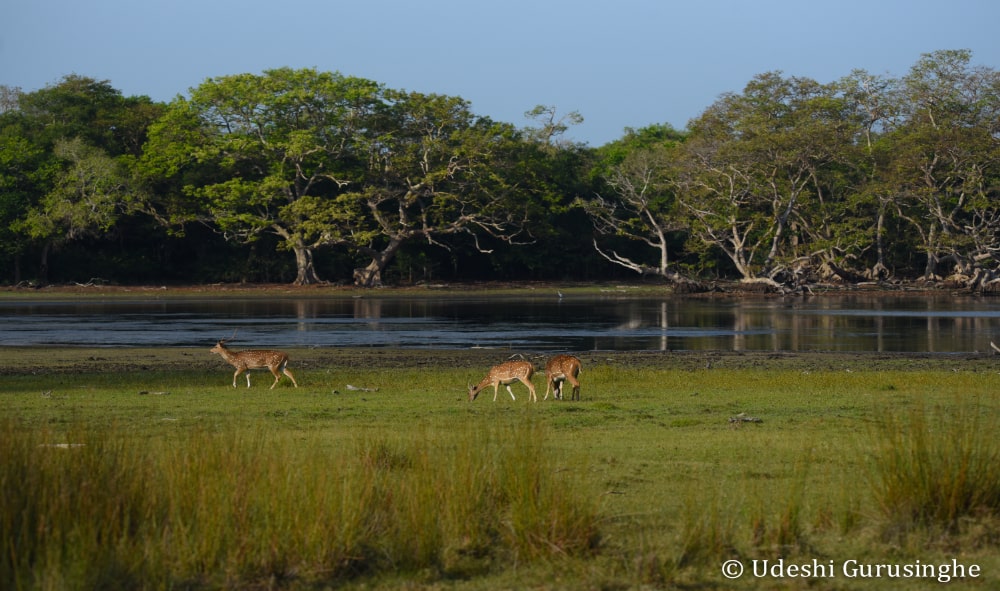Wilpattu National Park, located in the northwestern part of Sri Lanka, is the island’s largest and oldest national park, covering over 1,300 square kilometers. Known for its unique network of natural lakes, diverse wildlife, and pristine landscapes, Wilpattu is a haven for nature lovers, wildlife enthusiasts, and anyone seeking an immersive safari experience. This untouched wilderness offers visitors the chance to witness Sri Lanka’s rich biodiversity, including elusive leopards, majestic elephants, and an array of bird species.
A Unique Landscape of Villus
One of the most distinctive features of Wilpattu National Park is its villus, which are natural, shallow lakes scattered throughout the park. These villus play a crucial role in sustaining the park’s ecosystems, as they provide essential water sources for wildlife, especially during the dry season. The park is named after these lakes, with “Wilpattu” meaning “Land of Lakes” in Sinhala.
The landscape is a blend of dry tropical forest, scrubland, and open grasslands, creating varied habitats for a wide range of animal species. The peaceful, unspoiled environment of Wilpattu offers a sense of isolation and tranquility, far removed from the more tourist-heavy parks of Sri Lanka.
Diverse Wildlife and Iconic Species
Wilpattu is home to an extraordinary array of wildlife, making it one of the top destinations for safaris in Sri Lanka. Visitors to the park have the chance to spot some of the island’s most iconic and endangered species.
- Leopards: Wilpattu is renowned for its population of leopards, and while spotting these elusive big cats is never guaranteed, the park’s dense forests and quiet atmosphere provide an ideal habitat for them. Leopard sightings are one of the highlights of any safari in Wilpattu, and the park is considered one of the best places in Sri Lanka to catch a glimpse of this magnificent predator.
- Elephants: While Wilpattu is not as famous for elephants as other parks like Yala, it is still home to a significant population of these gentle giants. The open grasslands and water-filled villus make perfect feeding grounds for elephants, and seeing them roam freely in their natural habitat is a remarkable experience.
- Sloth Bears: Another highlight of Wilpattu is the presence of the endangered sloth bear. These shy creatures are typically harder to spot, but the park offers one of the best chances to observe them in the wild.
- Birdlife: Wilpattu is a paradise for birdwatchers, with over 200 species of birds recorded within the park. From vibrant peacocks and majestic eagles to smaller species like kingfishers and bee-eaters, the park’s diverse habitats support a wide range of avian life. The villus attract waterbirds such as herons, storks, and pelicans, making them a key feature of the park’s birdwatching opportunities.
Other animals frequently seen in Wilpattu include spotted deer, sambar deer, wild boar, water buffalo, mongooses, and crocodiles. The rich biodiversity of the park ensures that every safari offers something unique and memorable.
Safari Experience in Wilpattu
A safari through Wilpattu National Park is a peaceful and immersive journey into the wild. The park’s vast size and relatively low number of visitors create a more exclusive and tranquil experience compared to the busier parks in Sri Lanka. Visitors can explore the park in 4×4 safari jeeps, with early morning and late afternoon being the best times for wildlife viewing, as animals are more active during these cooler hours.
The park’s dense vegetation, winding dirt roads, and numerous villus offer a sense of adventure as you traverse through the different habitats in search of wildlife. Knowledgeable guides enhance the experience by providing insights into the behavior and ecology of the animals and pointing out lesser-known species along the way.
Conservation and History
Wilpattu National Park has a long history of conservation, having been designated a national park in 1938. Despite facing challenges such as poaching and habitat destruction during Sri Lanka’s civil conflict, the park has made a strong recovery and remains a vital area for wildlife conservation. Ongoing efforts to protect and preserve the park’s ecosystems are crucial to the survival of its endangered species.
Historically, Wilpattu also holds cultural significance. Within the park, there are ancient ruins, including old temples and reservoirs, that hint at the park’s rich human history, dating back to Sri Lanka’s ancient kingdoms. The area surrounding the park is also associated with early Sinhalese civilizations, adding a layer of cultural depth to the park’s natural beauty.
Best Time to Visit Wilpattu
The best time to visit Wilpattu National Park is during the dry season, which lasts from February to October. During this period, wildlife congregates around the villus and waterholes, increasing the chances of sightings. The dry weather also makes the park’s dirt roads more accessible for safari vehicles.
The park remains open year-round, but the rainy season, from November to January, can make some parts of the park difficult to navigate, and wildlife tends to be more dispersed due to the abundance of water.
Getting to Wilpattu National Park
Wilpattu National Park is located about 180 kilometers north of Colombo and can be easily reached by road. The drive from Colombo takes approximately 4-5 hours. For those traveling from Anuradhapura, one of Sri Lanka’s ancient capitals, the park is only about 50 kilometers away, making it a convenient day trip.
Accommodation Options Near Wilpattu
There are several accommodation options around Wilpattu National Park, ranging from budget-friendly guesthouses to luxury eco-lodges. Many of these accommodations are located just outside the park’s entrance, offering safari packages and guided tours. For those seeking a more immersive experience, some lodges offer camping safaris within the park, allowing visitors to fall asleep to the sounds of the jungle.
Wilpattu National Park is a truly special destination for those seeking an authentic and serene wildlife experience in Sri Lanka. Its vast wilderness, diverse wildlife, and unique villus make it a place where nature reigns supreme. Whether you’re hoping to spot a leopard lounging in the shade, an elephant by a watering hole, or simply want to bask in the beauty of Sri Lanka’s natural landscapes, Wilpattu offers an unforgettable adventure into the wild heart of the island.

